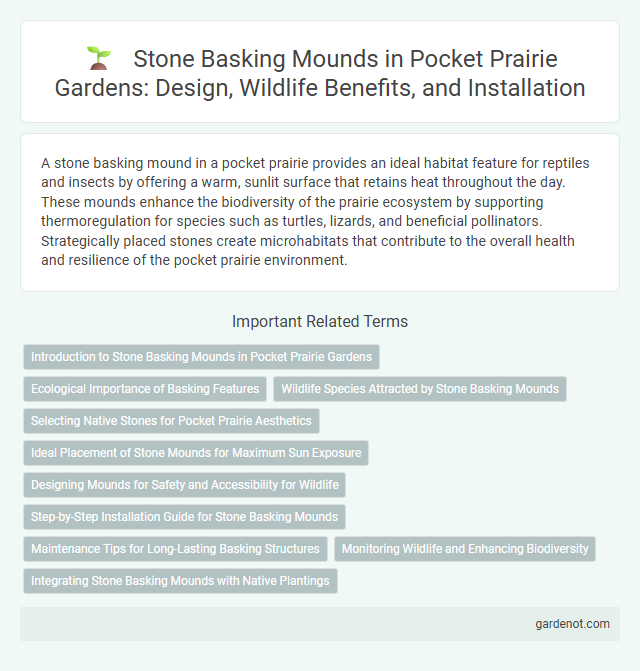A stone basking mound in a pocket prairie provides an ideal habitat feature for reptiles and insects by offering a warm, sunlit surface that retains heat throughout the day. These mounds enhance the biodiversity of the prairie ecosystem by supporting thermoregulation for species such as turtles, lizards, and beneficial pollinators. Strategically placed stones create microhabitats that contribute to the overall health and resilience of the pocket prairie environment.
Introduction to Stone Basking Mounds in Pocket Prairie Gardens
Stone basking mounds in Pocket Prairie gardens provide essential habitat structures for reptiles like turtles and lizards, promoting biodiversity. These mounds, typically constructed from naturally sourced stones, create warm, sunlit spots where cold-blooded animals regulate their body temperature. Integrating stone basking mounds enhances ecological balance by supporting native wildlife and contributing to microhabitat diversity.
Ecological Importance of Basking Features
Stone basking mounds in pocket prairies provide critical microhabitats for ectothermic species such as reptiles and insects, facilitating thermoregulation by offering sun-warmed surfaces. These structures enhance biodiversity by supporting pollinator and predator species that rely on temperature regulation for optimal activity. Incorporating stone features promotes ecosystem stability and resilience through the creation of essential thermal refuges within fragmented prairie landscapes.
Wildlife Species Attracted by Stone Basking Mounds
Stone basking mounds in pocket prairies attract a diverse range of wildlife species including reptiles such as eastern box turtles, skinks, and various snakes that rely on the warmth for thermoregulation. These mounds also provide essential habitat for insects like butterflies and dragonflies that use the stones for basking and refuge. Birds, including robins and sparrows, are frequently observed using stone mounds as lookout points to spot prey or survey their surroundings.
Selecting Native Stones for Pocket Prairie Aesthetics
Selecting native stones for a stone basking mound in a pocket prairie enhances ecological harmony and supports local wildlife. Prioritize irregularly shaped rocks sourced from the surrounding region to provide natural microhabitats for reptiles and insects. The texture and thermal properties of these native stones optimize heat absorption, creating ideal basking spots that blend seamlessly with the prairie environment.
Ideal Placement of Stone Mounds for Maximum Sun Exposure
Stone basking mounds in a pocket prairie should be positioned in areas receiving full sun for most of the day, typically facing south or southeast to maximize warmth. Placement on slightly elevated, well-drained ground prevents moisture buildup and enhances heat retention, creating optimal conditions for reptiles and beneficial insects. Avoiding shade from adjacent vegetation ensures consistent sun exposure, promoting effective thermoregulation.
Designing Mounds for Safety and Accessibility for Wildlife
Stone basking mounds provide essential sunning spots for reptiles and amphibians, designed with gradual slopes and stable surfaces to ensure safe and easy access for various wildlife species. Incorporating a mix of smooth and textured stones enhances grip and prevents injury, while positioning mounds near native vegetation offers shelter and quick escape routes. Strategic placement within pocket prairies not only supports thermoregulation but also promotes biodiversity by accommodating diverse species' movement and habitat needs.
Step-by-Step Installation Guide for Stone Basking Mounds
Stone basking mounds provide essential heat-retaining surfaces for reptiles in pocket prairies, enhancing their natural behavior and habitat. Begin by selecting flat, sun-exposed ground, then layer large, flat stones to create a stable, porous structure that absorbs and radiates solar warmth effectively. Ensure proper drainage by incorporating smaller rocks underneath and position the mound near sheltering plants for safety and comfort.
Maintenance Tips for Long-Lasting Basking Structures
Stone basking mounds require regular inspection to remove debris and prevent moss or algae buildup, ensuring a dry, warm surface for reptiles. Positioning stones with varying sizes and textures enhances heat retention and promotes easy drainage, reducing wear over time. Seasonal cleaning with mild, non-toxic solutions preserves stone integrity and maintains optimal basking conditions in pocket prairies.
Monitoring Wildlife and Enhancing Biodiversity
The stone basking mound in a pocket prairie provides critical habitat for reptiles and insects, encouraging species diversity and promoting ecological balance. Monitoring wildlife activity on these mounds reveals patterns in temperature regulation, species presence, and habitat usage, guiding targeted conservation efforts. Enhancing biodiversity through strategic placement and maintenance of stone mounds supports pollinators, small mammals, and beneficial arthropods essential to prairie ecosystem health.
Integrating Stone Basking Mounds with Native Plantings
Stone basking mounds provide essential heat-retaining surfaces that support native reptiles and amphibians in pocket prairies. Integrating these stone structures with native plantings enhances habitat complexity, promoting biodiversity by offering both shelter and food resources for wildlife. Strategic placement of stone basking mounds among prairie grasses and wildflowers maximizes ecological benefits and creates sustainable microhabitats.
Stone basking mound Infographic

 gardenot.com
gardenot.com